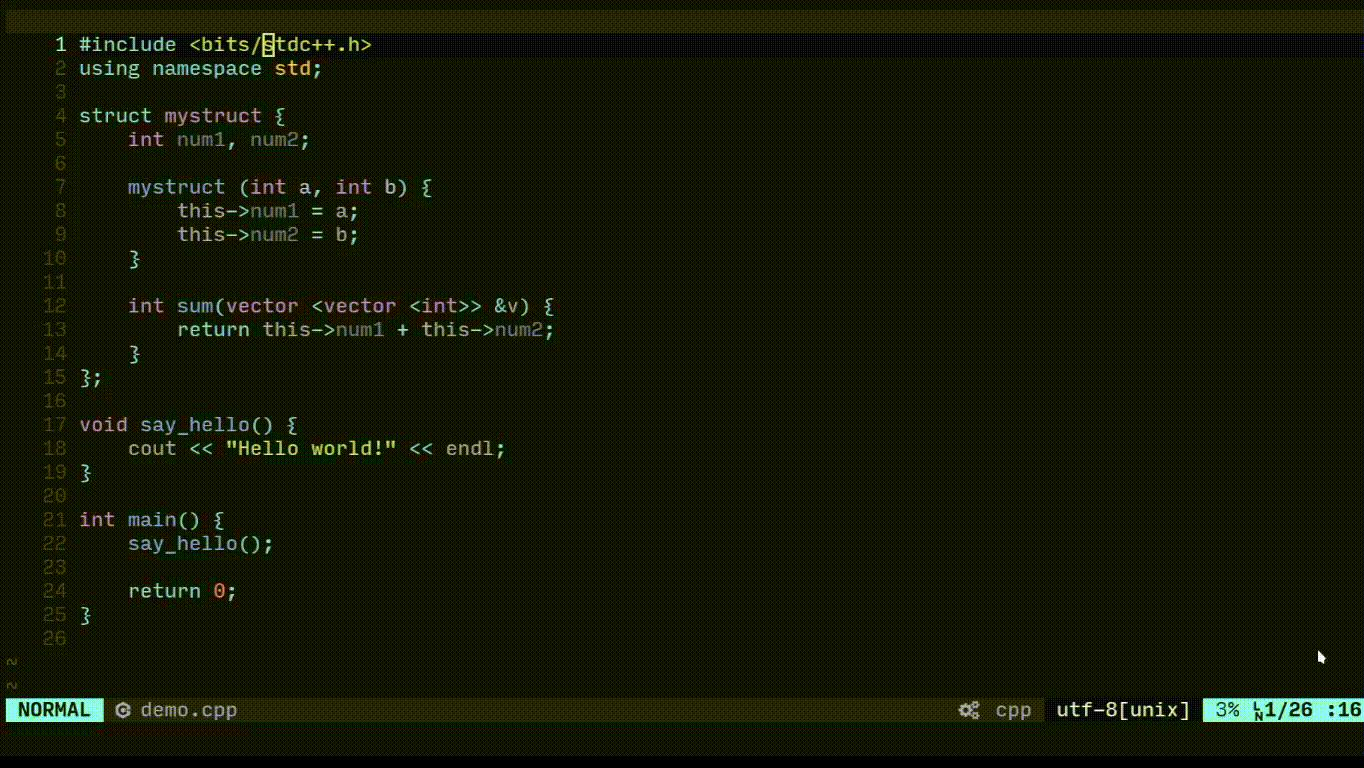A simple statusline/winbar component that uses LSP to show your current code context. Named after the Indian satellite navigation system.
- Neovim >= 0.7.0
- nvim-lspconfig
Install the plugin with your preferred package manager:
use {
"SmiteshP/nvim-navic",
requires = "neovim/nvim-lspconfig"
}Plug "neovim/nvim-lspconfig"
Plug "SmiteshP/nvim-navic"For nvim-navic to work, it needs attach to the lsp server. You can pass the nvim-navic's attach function as on_attach while setting up the lsp server.
Note: nvim-navic can attach to only one server per buffer.
Example:
local navic = require("nvim-navic")
require("lspconfig").clangd.setup {
on_attach = function(client, bufnr)
navic.attach(client, bufnr)
end
}Use the setup function to modify default parameters.
icons: Indicate the type of symbol captured. Default icons assume you have nerd-fonts.highlight: If set to true, will add colors to icons and text as defined by highlight groupsNavicIcons*(NavicIconsFile,NavicIconsModule.. etc.),NavicTextandNavicSeparator.depth_limit: Maximum depth of context to be shown. If the context hits this depth limit, it is truncated.depth_limit_indicatior: Icon to indicate thatdepth_limitwas hit and the shown context is truncated.
navic.setup {
icons = {
File = " ",
Module = " ",
Namespace = " ",
Package = " ",
Class = " ",
Method = " ",
Property = " ",
Field = " ",
Constructor = " ",
Enum = "練",
Interface = "練",
Function = " ",
Variable = " ",
Constant = " ",
String = " ",
Number = " ",
Boolean = "◩ ",
Array = " ",
Object = " ",
Key = " ",
Null = "ﳠ ",
EnumMember = " ",
Struct = " ",
Event = " ",
Operator = " ",
TypeParameter = " ",
},
highlight = false,
separator = " > ",
depth_limit = 0,
depth_limit_indicator = "..",
}
For highlights to work, highlight groups must be defined. These may be defined in your colourscheme, if not you can define them yourself too as shown in below code snippet.
Example highlight definitions
vim.api.nvim_set_hl(0, "NavicFile", {default = true, bg = "#000000", fg = "#ffffff"})
vim.api.nvim_set_hl(0, "NavicModule", {default = true, bg = "#000000", fg = "#ffffff"})
vim.api.nvim_set_hl(0, "NavicNamespace", {default = true, bg = "#000000", fg = "#ffffff"})
vim.api.nvim_set_hl(0, "NavicPackage", {default = true, bg = "#000000", fg = "#ffffff"})
vim.api.nvim_set_hl(0, "NavicClass", {default = true, bg = "#000000", fg = "#ffffff"})
vim.api.nvim_set_hl(0, "NavicMethod", {default = true, bg = "#000000", fg = "#ffffff"})
vim.api.nvim_set_hl(0, "NavicProperty", {default = true, bg = "#000000", fg = "#ffffff"})
vim.api.nvim_set_hl(0, "NavicField", {default = true, bg = "#000000", fg = "#ffffff"})
vim.api.nvim_set_hl(0, "NavicConstructor", {default = true, bg = "#000000", fg = "#ffffff"})
vim.api.nvim_set_hl(0, "NavicEnum", {default = true, bg = "#000000", fg = "#ffffff"})
vim.api.nvim_set_hl(0, "NavicInterface", {default = true, bg = "#000000", fg = "#ffffff"})
vim.api.nvim_set_hl(0, "NavicFunction", {default = true, bg = "#000000", fg = "#ffffff"})
vim.api.nvim_set_hl(0, "NavicVariable", {default = true, bg = "#000000", fg = "#ffffff"})
vim.api.nvim_set_hl(0, "NavicConstant", {default = true, bg = "#000000", fg = "#ffffff"})
vim.api.nvim_set_hl(0, "NavicString", {default = true, bg = "#000000", fg = "#ffffff"})
vim.api.nvim_set_hl(0, "NavicNumber", {default = true, bg = "#000000", fg = "#ffffff"})
vim.api.nvim_set_hl(0, "NavicBoolean", {default = true, bg = "#000000", fg = "#ffffff"})
vim.api.nvim_set_hl(0, "NavicArray", {default = true, bg = "#000000", fg = "#ffffff"})
vim.api.nvim_set_hl(0, "NavicObject", {default = true, bg = "#000000", fg = "#ffffff"})
vim.api.nvim_set_hl(0, "NavicKey", {default = true, bg = "#000000", fg = "#ffffff"})
vim.api.nvim_set_hl(0, "NavicNull", {default = true, bg = "#000000", fg = "#ffffff"})
vim.api.nvim_set_hl(0, "NavicEnumMember", {default = true, bg = "#000000", fg = "#ffffff"})
vim.api.nvim_set_hl(0, "NavicStruct", {default = true, bg = "#000000", fg = "#ffffff"})
vim.api.nvim_set_hl(0, "NavicEvent", {default = true, bg = "#000000", fg = "#ffffff"})
vim.api.nvim_set_hl(0, "NavicOperator", {default = true, bg = "#000000", fg = "#ffffff"})
vim.api.nvim_set_hl(0, "NavicTypeParameter", {default = true, bg = "#000000", fg = "#ffffff"})
vim.api.nvim_set_hl(0, "NavicText", {default = true, bg = "#000000", fg = "#ffffff"})
vim.api.nvim_set_hl(0, "NavicSeparator", {default = true, bg = "#000000", fg = "#ffffff"})nvim-navic does not alter your statusline or winbar on its own. Instead, you are provided with these two functions and its left up to you how you want to incorporate this into your setup.
is_available(): Returns boolean value indicating whether output can be provided.get_location(): Returns a pretty string with context information.
Examples
An example feline setup
local navic = require("nvim-navic")
table.insert(components.active[1], {
provider = function()
return navic.get_location()
end,
enabled = function()
return navic.is_available()
end
})
require("feline").setup({components = components})
-- OR
require("feline").winbar.setup({components = components})An example lualine setup
local navic = require("nvim-navic")
require("lualine").setup({
sections = {
lualine_c = {
{ navic.get_location, cond = navic.is_available },
}
}
})If you have a creative use case and want the raw context data to work with, you can use the following function
get_data(): Returns a table of intermediate representation of data. Table of tables that contain 'kind', 'name' and 'icon' for each context.
An example output of get_data function:
{
{
name = "myclass",
type = "Class",
icon = " ",
kind = 5
},
{
name = "mymethod",
type = "Method",
icon = " ",
kind = 6
}
}